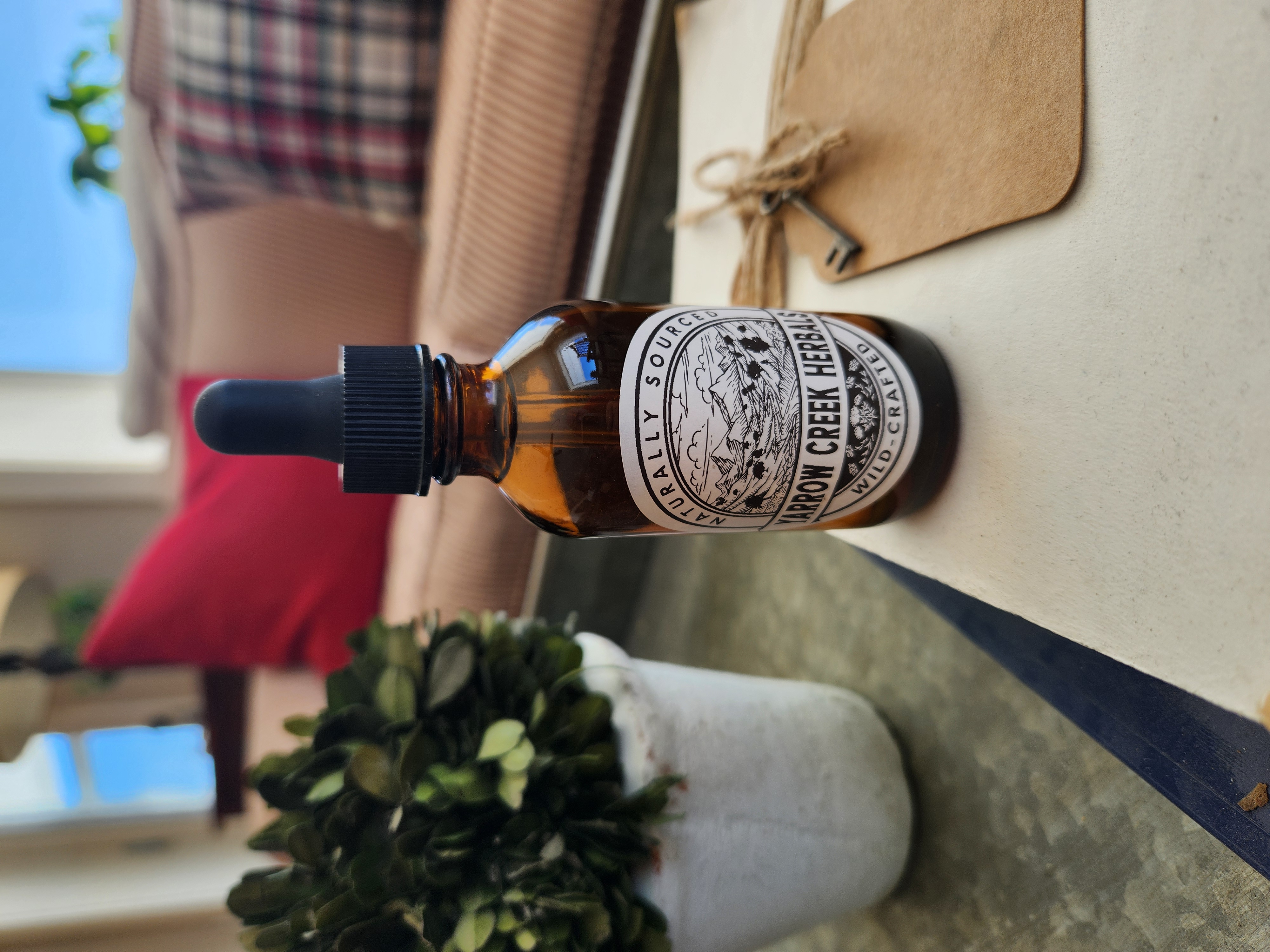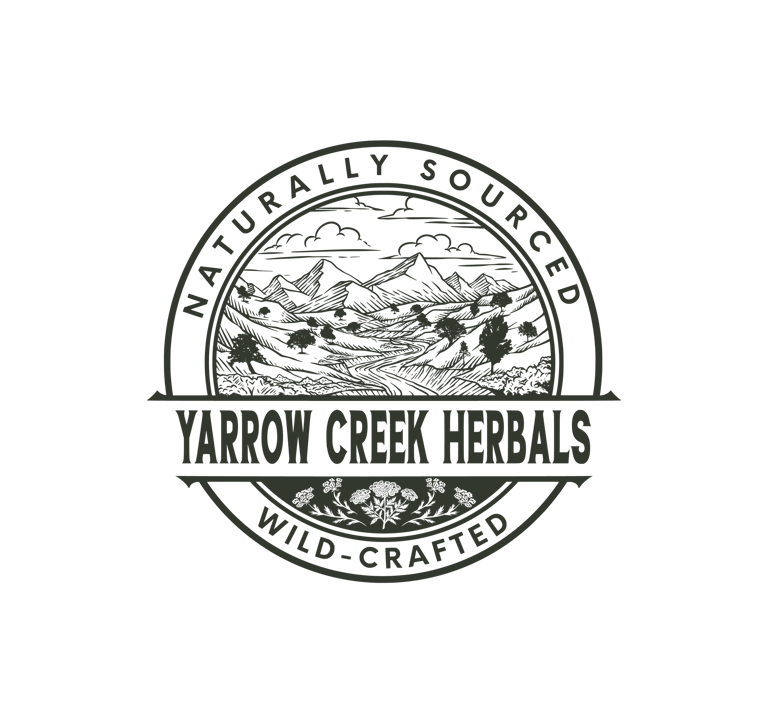
Glow Facial Oil
Radiance in a Bottle
CA$32.00
Herbal Highlights & Research
Yarrow (Achillea millefolium)
• Contains flavonoids and sesquiterpene lactones with anti-inflammatory and wound-healing activity; topical extracts have shown improved collagen deposition and tissue repair https://www.ncbi.nlm.nih.gov/pmc/articles/PMC10809340/
• Traditional use: Applied as poultices and washes for cuts, bruises, and rashes as one of the oldest European skin remedies.
Calendula (Calendula officinalis)
• Rich in triterpenoids and carotenoids; clinical studies confirm topical calendula accelerates wound closure, reduces inflammation, and supports regeneration of the skin barrier https://pubmed.ncbi.nlm.nih.gov/31145533/
• Traditional use: Made into salves, teas, and washes to soothe burns, rashes, cuts, and irritations in European and Western folk medicine.
Mint (Mentha spp.)
• Topical menthol (derived from Mentha species) has demonstrated wound-healing and anti-inflammatory effects in animal models, reducing inflammatory markers, stimulating antioxidant defense, and enhancing epithelial regeneration — supportive for skin-soothing oils
• Traditional use: Applied fresh as a cooling herb to ease heat, redness, and congestion in the skin.
Wild Rose (Rosa spp.)
• Scientific studies on Rosa gallica show that rose petals are naturally rich in antioxidants that help calm inflammation and protect skin from sun-related aging. Extracts have been shown to reduce stress signals in the skin after UV exposure, supporting long-term resilience https://pmc.ncbi.nlm.nih.gov/articles/PMC6261181/
• Additional research on Rosa gallica demonstrates that rose extracts can slow pigment formation, protect collagen, and reduce wrinkle formation — benefits that support brighter, more even-toned, and firmer skin
https://pmc.ncbi.nlm.nih.gov/articles/PMC6811464/
• While these studies are on Rosa gallica, wild rose (Rosa spp.) shares similar phytochemical compounds and traditional uses, making it a trusted ally in folk beauty and skin health.
• Traditional use: Infused into waters and oils to soften the skin, strengthen resilience, and add a gentle fragrance in folk beauty rituals.
Jojoba Oil (Simmondsia chinensis)
• Jojoba oil is structurally similar to our skin’s own sebum, allowing it to balance oil production and prevent dryness. Research confirms it helps the skin hold onto water by reducing transepidermal water loss (TEWL)
https://pubmed.ncbi.nlm.nih.gov/24442052/
• Traditional use: Used by Indigenous desert peoples to moisturize, protect, and soften skin in dry climates.
Castor Oil (Ricinus communis)
• Castor oil is made up mostly of ricinoleic acid, which makes it deeply moisturizing and protective. It creates a light barrier on the skin that locks in hydration and softens rough, cracked areas
https://www.cir-safety.org/sites/default/files/Castor%20Oil.pdf
• Research also shows it has antimicrobial and anti-inflammatory effects, helping calm irritation while protecting against certain bacteria — making it a strong ally in barrier repair formulas https://pubmed.ncbi.nlm.nih.gov/11200362/
• Traditional use: Commonly applied in poultices, salves, and balms for dry hands, cracked heels, and weather-worn skin — long valued as a staple oil for rough patches.
Glow Oil was made for skin that feels tight, weather-worn, or dulled by the harsh winds of southern Alberta. This concentrated facial oil restores hydration, calms inflammation, and strengthens the barrier where it matters most. Instead of sitting on the surface, it sinks in deeply: jojoba and castor oils replenish protective lipids and seal in moisture, while yarrow, calendula, mint, and wild rose deliver antioxidant and anti-inflammatory compounds to repair and defend stressed skin.
Barrier support is at the heart of this formula. Jojoba oil mimics the skin’s natural sebum, helping restore suppleness and reducing transepidermal water loss. Castor oil lays down a thin protective film to lock in hydration. Yarrow and calendula ease irritation and promote repair, while rose polyphenols defend against oxidative stress. Together, they help skin hold moisture, resist inflammation, and recover resilience after exposure to cold, wind, and dryness.
I originally blended Glow Oil for myself — a night remedy when my skin felt stripped and tired from Alberta’s climate. I massage a few drops into damp skin before bed, letting it soften and restore overnight. But it’s light enough for daytime use too, whether worn alone or under makeup as a shield against the elements.
For best results, pair it with our Skin Remedy Mist: mist first for hydration, then seal it in with Glow Oil. Used together, they form a complete herbal system that calms irritation, strengthens the barrier, and restores glow season after season.
Glow Oil isn’t just another moisturizer. It’s barrier repair, antioxidant protection, and traditional herbal care distilled into one simple step — a clinical formula shaped by tradition, crafted for resilience and radiance.
How to Use
• Massage 2–4 drops into clean, slightly damp skin on the face, neck, or décolletage.
• Use as the final step in your evening routine, or layer over a hydrosol for enhanced absorption.
• May also be used as a spot treatment for areas of irritation or dryness.
Ingredients
Jojoba oil (Simmondsia chinensis), Castor oil (Ricinus communis), Yarrow (Achillea millefolium), Calendula (Calendula officinalis), Mint (Mentha spp.), Wild Rose (Rosa spp.).
Safety Note
For external use only. Perform a patch test before first use to ensure compatibility. Discontinue if irritation occurs. Not recommended on broken skin or for those allergic to the daisy family (Yarrow, Calendula).
See Disclaimer / Terms and Conditions for shelf life guidelines.
